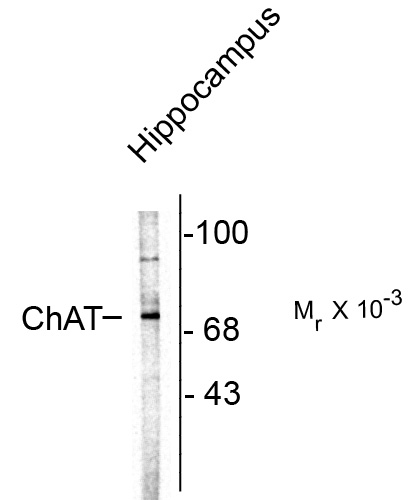Choline Acetyltransferase Antibody
Affinity purified goat polyclonal antibody
- SPECIFICATION
- CITATIONS
- PROTOCOLS
- BACKGROUND

Application
| WB |
|---|---|
| Primary Accession | P28329 |
| Reactivity | Human, Mouse, Pig, Chicken |
| Host | Goat |
| Clonality | polyclonal |
| Calculated MW | 70 KDa |
| Gene ID | 1103 |
|---|---|
| Gene Name | CHAT |
| Target/Specificity | Native choline acetyltransferase purifed from human placenta. |
| Dilution | WB~~1:100 |
| Format | Prepared from goat serum by affinity purification using a column to which the protein immunogen was coupled. |
| Antibody Specificity | Specific for the ~ 70k choline acetyltransferase protein. |
| Storage | Maintain refrigerated at 2-8°C for up to 6 months. For long term storage store at -20°C in small aliquots to prevent freeze-thaw cycles. |
| Precautions | Choline Acetyltransferase Antibody is for research use only and not for use in diagnostic or therapeutic procedures. |
| Shipping | Blue Ice |

Thousands of laboratories across the world have published research that depended on the performance of antibodies from Abcepta to advance their research. Check out links to articles that cite our products in major peer-reviewed journals, organized by research category.
info@abcepta.com, and receive a free "I Love Antibodies" mug.
Provided below are standard protocols that you may find useful for product applications.
Background
Choline acetyltransferase is a neuronal enzyme which catalyzes the reaction between Acetyl CoA and choline resulting in the formation of acetylcholine. It is therefore found primarily in cholinergic neurons making it a valuable marker for diseases associated with decreased cholinergic function such as Schizophrenia, Alzheimer disease (AD) and Down syndrome (Holt et al. 1999). Decreased choline acetyltransferase activity in particular has been shown in Schizophrenic subjects (Karson et al 1993). It has furthermore been demonstrated that in patients with AD, there are significantly lower levels of cortical ChAT that correlate with severity of the disease as measured by loss of neuropsychological function (Baskin et al. 1999).
References
Karson CN, Casanova MF, Kleinman JE, Griffin WS (1993) Choline acetyltransferase in schizophrenia. Am. J.Psychiatry 150:454-459.
Holt DJ, Herman MM, Hyde TM, Kleinman JE, Cinton CM, German DC, Hersh LB, Greybiel AM, Saper CB (1999) Evidence for a deficit in cholinergic interneurons in the striatum in schizophrenia. Neuroscience 94(1):21-31.
Baskin DS, Browning JL, Pirozzolo FJ, Korporaal S, Baskin JA, Appel SH (1999) Brain choline acetyltransferase and mental function in Alzheimer disease. Arch Neurol. 56:1121-1123.
If you have used an Abcepta product and would like to share how it has performed, please click on the "Submit Review" button and provide the requested information. Our staff will examine and post your review and contact you if needed.
If you have any additional inquiries please email technical services at tech@abcepta.com.













 Foundational characteristics of cancer include proliferation, angiogenesis, migration, evasion of apoptosis, and cellular immortality. Find key markers for these cellular processes and antibodies to detect them.
Foundational characteristics of cancer include proliferation, angiogenesis, migration, evasion of apoptosis, and cellular immortality. Find key markers for these cellular processes and antibodies to detect them. The SUMOplot™ Analysis Program predicts and scores sumoylation sites in your protein. SUMOylation is a post-translational modification involved in various cellular processes, such as nuclear-cytosolic transport, transcriptional regulation, apoptosis, protein stability, response to stress, and progression through the cell cycle.
The SUMOplot™ Analysis Program predicts and scores sumoylation sites in your protein. SUMOylation is a post-translational modification involved in various cellular processes, such as nuclear-cytosolic transport, transcriptional regulation, apoptosis, protein stability, response to stress, and progression through the cell cycle. The Autophagy Receptor Motif Plotter predicts and scores autophagy receptor binding sites in your protein. Identifying proteins connected to this pathway is critical to understanding the role of autophagy in physiological as well as pathological processes such as development, differentiation, neurodegenerative diseases, stress, infection, and cancer.
The Autophagy Receptor Motif Plotter predicts and scores autophagy receptor binding sites in your protein. Identifying proteins connected to this pathway is critical to understanding the role of autophagy in physiological as well as pathological processes such as development, differentiation, neurodegenerative diseases, stress, infection, and cancer.


